Extract Of Related Documentation
For better accessibility, here are some chapters taken from other basic manuals.
Articles - page ES
The E-shop tab is intended for the specification of all data on articles sold on the K2 E-shop. The page is visible for a user who has the right to Browse the ES page in the book of Articles in the section Webs and E-shops - Articles - Browse the ES page in the book of Articles. Only those users who have the right to Change the ES page in the book of Articles (Webs and e-shops - Articles - Browse the ES page in the book of Articles) can change the data here.
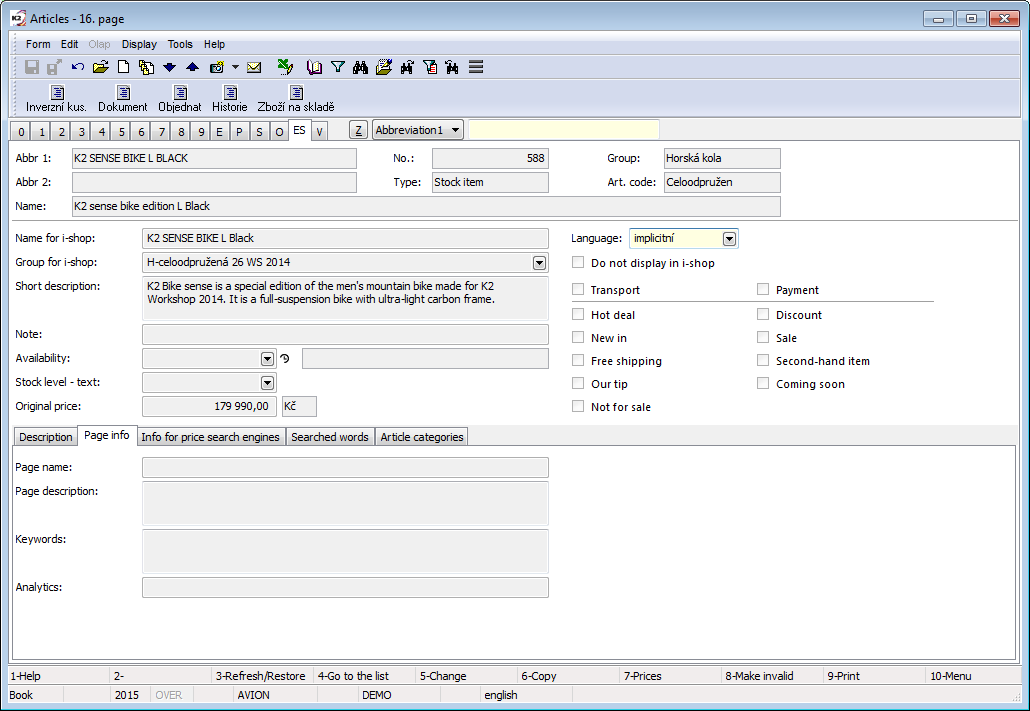
Picture: E-shop tab
Description of Fields:
Name for e-shop |
The unique name of the article, which will be used to name the article in the e-shop. |
Group for e-shop |
Group of article to classify the article to e-shop. |
Short description |
An article description that informs what the product is about and why the customer should buy it. It is displayed in the detail in the product catalogue just below the product name. |
Note |
The text of note will be published in the detail of the article, in the pre-basket, basket and comparison. |
Text at zero warehouse* |
The text that will be displayed if the articles are not in stock and at the same time the Alternative text is not filled in. Texts can be suppressed in bulk with the Show actual warehouse statuses flag in the Web and E-shop settings. |
Alternative text* |
The text that is displayed when the warehouse status is specific. Texts can be suppressed in bulk with the Show actual warehouse statuses flag in the Web and E-shop settings. |
Original price |
The original price stated in this field is displayed / hidden in the article detail depending on the - flag Show "original price" in Web and E-shop settings - Catalogue of articles. You can enter the price without VAT, then it is displayed on the e-shop according to the settings for displaying prices without tax or tax. |
Transport / Payment |
The option will be checked in the case of an Article card representing transport / payment. The marking allows the cards not to be transferred to an order created as a copy of another order - then only the Articlecards will be transferred. At the same time, the articles marked in this way will be displayed on the e-shop even if they have a set zero price (regardless of the Do not display articles at zero price flag in the Web and e-shop settings. |
* Text at zero warehouse and Alternative text can also be suppressed with the option Disallow sale of available articles. This can be found in the Web and e-shop settings, on the Article Catalogue tab. The user can thus limit the sale of articles for which, for example, the Text at zero warehouse is set to 2 weeks. In this case, the customer will not have a Buy button available on the e-shop.
At the bottom of the page you will find several tabs:
The Long description tab contains text in which you can explain in more detail which product it is. The long description is displayed in the product detail under the Description tab.
The Page Info tab is important as a so-called search engine optimization. The content of these fields is only the content of the page code for automata. They are not displayed to a normal e-shop / website user, but they can significantly affect website traffic if they are set up correctly.
On the Info for price search engines tab the data needed for the active use of web and e-shop information in various search engines and price comparators are given.
The Search words tab contains passwords that are associated with the articles and according to which the customer can search the web / e-shop. It can be, for example, colloquial names, usual customer typos, but also, for example, 1 + 1 text for free, etc.
On the Article category tab, it is possible to assign articles to a category. If the item has an Article group assigned to it, the category where that group is used is automatically added here. An entry added here using the Ins key is indicated in the table by a manual edit icon ![]() .
.
On the Flags for shops tab you can set flags Hide on e-shop (Articles are not filled into EsGoods and EsGoodsPrice tables after recalculation, then not available on eshop), New, Actions, Discount, Sale, Free shipping, Tip, We are preparing, Used Articles, Non-sale Articles (Articles cannot be added to the basket) and Sale to registered users (Articles are added to the basket only by the logged-in user). The Default category is also set here, which is to be displayed if the articles are included in more than one category of the same web/e-shop. The Inquire only flag has not been implemented yet. All the above-mentioned flags can be set for individual shops manually using line editing. If you exclude the article from e-shop, the line is marked as invalid by icon ![]() .
.
Shift+F8 delete the e-shop on the Flags for e-shops tab
If we cancelled the e-shop and no longer want to see the flag on the articles on the flags for e-shops tab, it is possible to use the Shift+F8 function.
The function is available in the Webs and e-shops books. Above the invalid e-shop / website, press the Shift+F8 keys - this function deletes the records (in the Articles book on the Flags for e-shops tab) for all articles that have been assigned to the e-shop.
The function is active with the right: Webs and e-shops / Administration / Delete web, e-shop data
Note.-
If the articles have been discarded firstly, i.e. the e-shop has a red circle flag (see above), after paying the e-shop, then the article will not be assigned back to the e-shop.-
If the article is still connected to the e-shop and you use the Shift+F8 function, after validating the e-shop (and starting the recalculation), the article remains assigned to the e-shop.
Articles - Article Variants
Article variants are defined on the Sales tab in the Article Variants sub-tab. They are intended for assigning to a article group under one product, which will represent its variants.
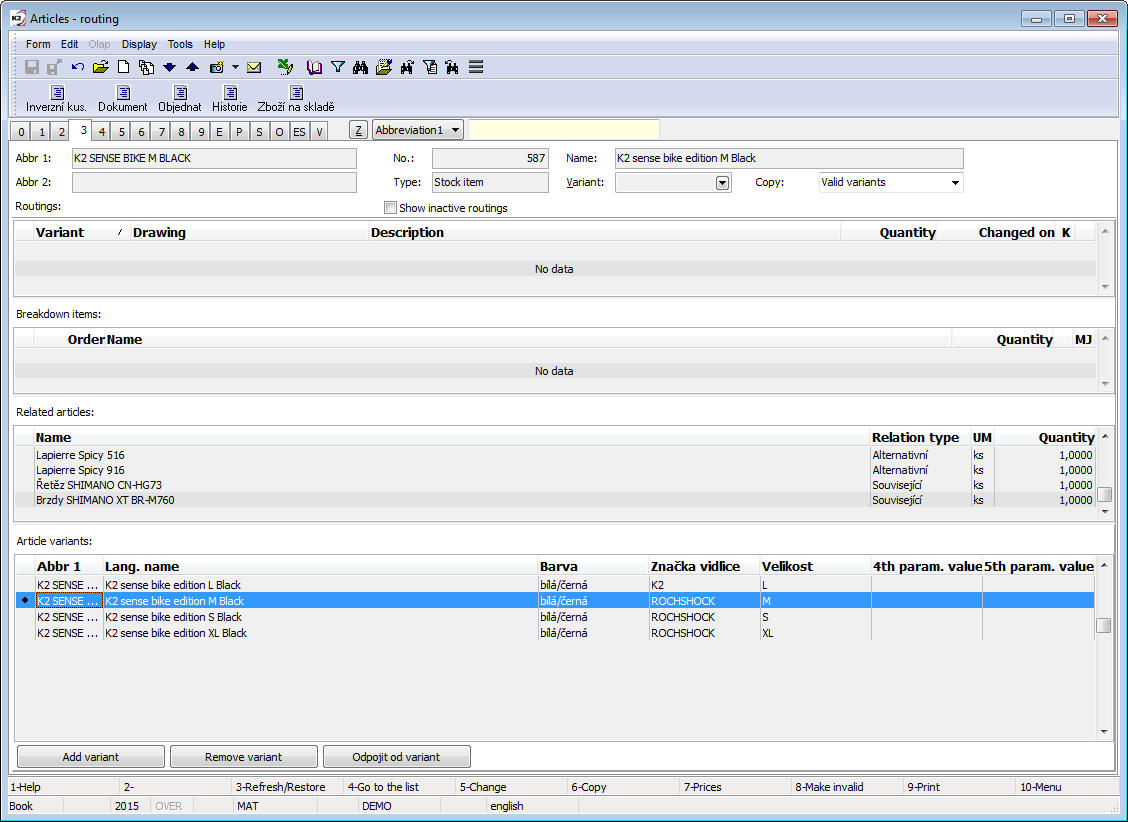
Pict.: Book Articles - Sales tab - Article Variants (for web/e-shop K2)
If you also want to see some (especially distinguishing) parameters for the Articles cards, you must set the property Parameter for Distinguishing the Article Variant for such parameters (in the parameter tree) in the Classification on the Parameters tab. The table shows the first 5 parameters with this flag.
It is possible to link only article cards with the same classification, i.e. with the same parameters determining the resolution of the article variant.
If you want to attach another article variant to the article card, you need:
- Have the same Classification defined on the Parameters tab for the article cards that you want to link.
- At least one parameter with the property “Parameter for variant resolution” must be included in the classification and must be filled in.
- Then select the “Add Variant” function while browsing. Only those article cards that have the same Classification are pre-filtered. Similarly, the article card would be disconnected from the variant or variant from the article card, using the appropriate functions under the grid.
- The interconnection of variants is always mutual, i.e. there will be interconnection of variants on all article cards.
Master Cards
It is a superior article card for individual variants of articles. This article card is defined by the Article Type Master Card. It is not possible to insert the master card on the documents in K2 or add it to the shopping card on the e-shop. It is a carrier of summation information, i.e. the Master Card layout is the sum of all subordinate variants or the price displayed on the e-shop is always displayed as the “price from”, while the “price from” is the lowest price of one of the subordinate variants.
Articles - Parameters tab
The tab enables to register the structured information of technical character to the Article cards - so called Parameters. Their list can be created separately for each card by Ins key, or it is possible to use predefined lists - so called Classification. This predefined list on the Article card you can any complement by other parameters (this inserted parameter will have flag of manual insertion) but these parameters will remain on the card only in the case they will be filled with a value. Each parameter on the Article card or in Classification has to have assigned the Group from list of groups. The parameter can occur only once on the one Article card or in one Classification.
If you change Classification on the Article card, a list of the parameters will be changed automatically. But the parameters with filled in values remain as manually inserted.
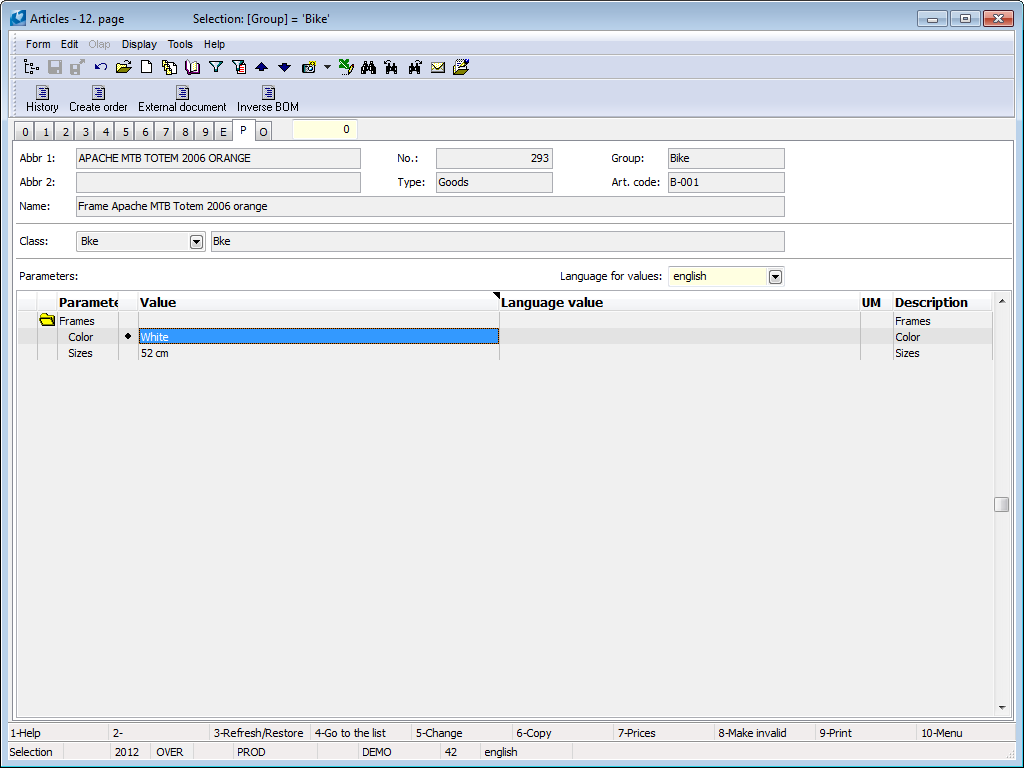
Picture: The Articles book - Parameters tab
Editing of the parameter values
The parameter values you can change by three ways:
- During the inserting of free parameter you enter the value directly in form for selection of parameter.
- You edit the particular parameters by so called line editing - in the column Value you press Enter key, you enter/select required value from the list and by Enter key you confirm entered value. At parameter with option of enumeration values the same form opens as during the inserting of parameter (point 1). In a list of the values you mark values, which are valid for appropriate goods. By pressing of the button OK you close the form. These selected values, consecutively separated by semicolon, will display in the column Value.
- If you enter all values to the one group, you could use form for entering of more values at once. On the group you press combination of keys Shift + Enter. The form to enter the parameter values will be displayed in the group. Here you can enter the required values directly to the fields Value to the particular parameters. You can open the list of predefined values by F12 key in the case of order (selection of a list or enumeration values). You can choose the value by Enter key. You can mark the required values at enumeration
 and you can close the list by Enter key or Tab.
and you can close the list by Enter key or Tab. - Also you can use this variant in case that you enter so called the comparative values at parameter or you want to change unit of parameter value.
Note: Comparative value - there are parameters whose value develop so much that the previously used unit is no longer practical (clear) and in some cases another unit is mentioned. However if you want to search according this parameter, subsequently for example in e-shop, it is necessary that the system compares absolute value in the same unit. "Hard drives" are the examples. Previously their capacity was stated in "GB" (gigabyte) but today the common capacity is in "TB" (terabyte). Therefore you can state the value "1 TB" to the disc and write the number "1000" to the comparison value.

Picture: A form for entering the parameter values in the group
In Classification in the Change mode, it is possible to move the item (parameter or group) on which the ruler stays, using the gray + and -. The parameter form can be displayed from the 1st page of the Classification or in the table on the 'P' page using the Ctrl+Shift+Enter keys.
The Parameters book
By the Parameter the properties that are related to an Article card are registered. The colour, weight, material, length, speed, Supported file formats etc. might be an example.

Picture: The Parameters book
The Basic Data tab of the Parameter tab is used to define the properties of the parameter.
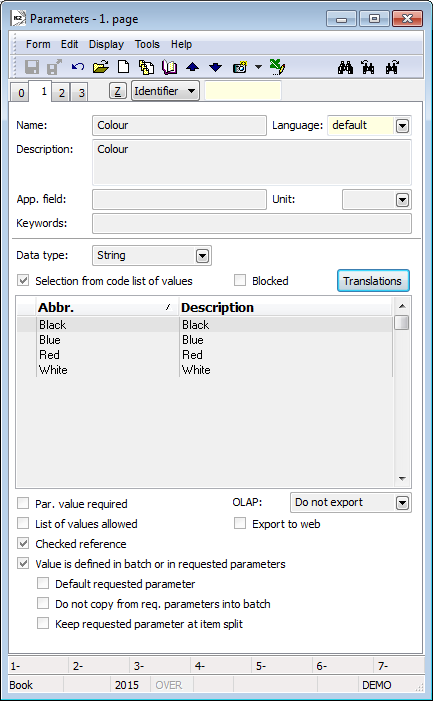
Picture: The Parameter book - Basic data
Description of Fields:
Name |
The parameters name. |
Description |
The description that can be exported e. g. to the e-shops as a explanation of a parameter content. |
App. field |
Working description for a better orientation among the similar parameters, it can briefly summarize the parameter setting. |
Unit |
The link to the code list of unit parameters. If it is filled in, it has to correspond to the record from a code list. |
Keywords |
For the export possibility to e-shop. |
Data type |
The kind of an expected value. Text, Integer number, Decimal number, Date, Time, Field from article card are offered. If the number is selected, next field is displayed and you can define a number format there. In the case of the Field from article card option the next field will be displayed too, and you should select to which field or note the parameter would refer from an Article card. You can use a linkage field too, in this case the link is indicated by semicolon. The link to a note type is written as "P@type" of a note, also e. g. to a business text you can link by "P@DH". |
Selection from code list of values |
The option provide a possibility to display to an user the list of predefined values. |
Par. value required |
If a parameter is obligatory, the Article card, where this parameter is inserted by the Classification, can not be saved without filling of a parameter value. This applies only to users who have the right to fill in the parameter values. |
The value is defined on the batch or the required parameters |
This option does not allow entering parameter values on the 'P' page. To distinguish individual article deliveries or production batches, you can enter values directly on batches. The parameter is therefore not generally valid for articles. The Batch Type is also saved internally in the batch. The Classification with parameters containing the flag "Value is defined on the batch or the required parameters" will be generated by the new batch type with each relevant change of the Classification (i.e. especially items) or parameters (flag, data type). Without this symptom, old batches would report an inconsistency in this case. |
Default required parameter |
The parameter with this option will be inserted by default when the newly created required parameter is created on the P/S item in the Parameters tab. The option is active only if the option Value is defined on the batch or the required parameters is checked. |
Do not transfer from the required parameters to the batch |
A parameter with this option will not be transferred from the required parameters to the batch when it is created (e.g. by receipt confirmation) and will not be displayed on the 'P' page. The option is active only if the option Value is defined on the batch or the required parameters is checked. This parameter can be used as an auxiliary parameter when defining a multidimensional quantity. |
Keep the required parameter when splitting the item |
Selecting a parameter causes the values to be copied to the newly created set of required parameters when splitting the purchase/sale items. We recommend to check the option for such parameters for which you do not want to lose their values when splitting the item. On the contrary, for parameters that explicitly require re-entry of values after splitting the item, this option does not have to be checked, but we recommend to check the Compulsory data option for such a parameter so that in case of omitting to enter a new value, the document with empty value is not confirmed. |
List of allowed values |
It enables to select and mark more values, that the Article card fulfils, from the list of predefined values. This possibility is useful e. g. if you want to create the list of supported picture formats for cameras. In the predefined values you can define all known and used picture formats and then at a concrete camera you can mark all these that the camera can create or process. |
Checked linkage |
It solves the ability for the user to enter a value other than the predefined value when selecting predefined values. In the case of enumeration the control is obligatory, that means it is possible to select values only from the list. |
Export to web |
It helps to ignore or place the parameter in the export to the e-shop. |
OLAP |
This option provides the ability to export parameter values as OLAP dimension. |
The list of Groups and the list of Classifications where a parameter is saved as a predefined is displayed on this parameter page.
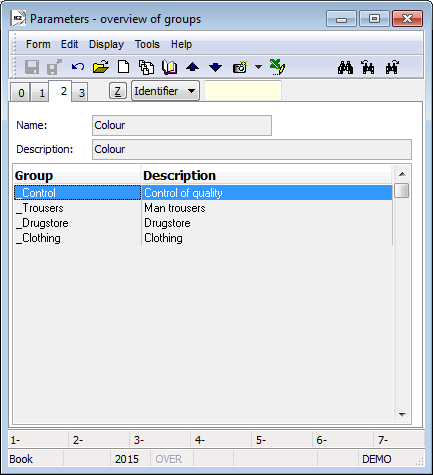
Picture: The Parameter book - Places of use
Code list of Groups
Parameters groups have got a double meaning. It enables to sort the list of the parameters in the Classification or on the Article as they belong logically to each other. In this case you can insert a parameter and than you can choose an appropriate group.

Picture: The Parameters groups book
The second option is to use the meaning of the group, which we often use for the same list of parameters. For example the group Packaging always contains the same parameters: The English instructions (yes/no); Box size (small, middle, large); Packaging content (text string for listing content). During the setting up of the group you directly add these parameters to the group. Any time in the Classification you want to describe package, you insert all group with predefined parameters.
You insert the parameters to the list by Ins key, you delete by Delete key. You can edit a parameter order by Gray Plus and Gray Minus. That group will be visible on the 2nd page on the parameters used in the group. Updating the list of parameters in a group will not affect any existing classifications.
The Class book
The Class predefines the list of parameters, their class to the groups and determining the order, in which they will be displayed. You can use the predefined class on a random number of the article cards.
Basic data
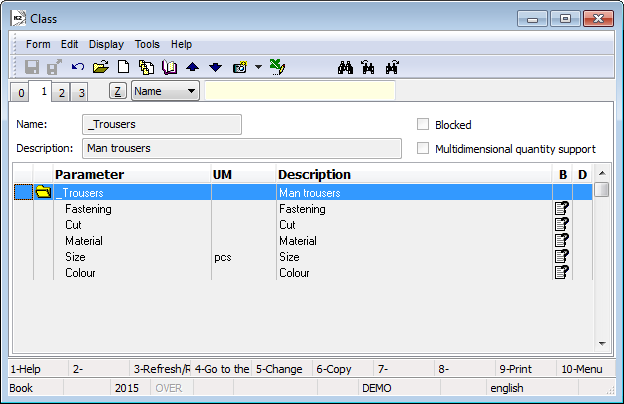
Picture: The Class book - Basic data
Into the table you can insert the list of parameters which are divided to the groups (marked ![]() ). Two options are available:
). Two options are available:
- You can insert them one by one by Ins key - to select parameter, to assign a group to it and to insert into the list by OK button.
- The second option how to use the predefined lists of the parameters in the groups - press Shift+Ins keys, choose the one from the list of groups and insert it into Class. The group with all its predefined parameters will be inserted. However, we do not have to follow the order of parameters or the content of group, the groups are used only for simplified insertion.
You can randomly delete the parameters by Delete key. By the same way you can delete the whole group - just press the Delete key when the light indicator is positioned on the group. You can randomly edit the order of parameters by the Gray Plus and Gray Minus keys. Later change of Class will be displayed to the article cards where the class is used.
Fields Description:
Blocked |
Block / invalidate Class. |
Multidimensional quantity support (VRM support) |
If there is at least one formula for multidimensional quantity on the 3rd page of the Class parameters tab, then the program automatically activates this option. For a more detailed description of the meaning and use of a multidimensional quantity, see the Basic code lists and Supporting Modules K2 / Articles / Articles Methods / Multidimensional Quantities. |
By clicking on the parameter, you will display a form with setting options for the e-shop:
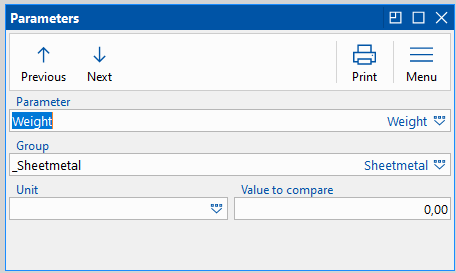
Picture: Parameter class
Fields Description:
Lower value in the parameter value is better |
It is not implemented |
Higher value in the parameter value is better |
It is not implemented |
Parameter to distinguish article variants |
Parameter to distinguish article variants on the 3rd page of an article card. |
Do not show in internet shop |
The parameter does not appear in e-shop. |
Formulas for VRM
On the Formulas for VRM tab, you can add formulas for multidimensional quantities.
Description of Fields:
Unit |
Specifies for which stock unit the formula applies. In the case of activated option Valid for release or Valid for receipt the formula is used in the case of agreement stock unit with unit in the sale or purchase item. In the case of activated option Formula to determine coeff. the stock unit is important if the same unit is selected by the user in the Batch book - then the quantitative values (Disposition, Assigned) are recalculated based on the coefficient in batch. |
Formula |
Formula for calculating the value. Enter individual parameter identifiers (e.g. V67) to the field. |
Variables for entering quantities |
Here are those variables you need to enter on the Purchase / Sales item (in the Multidimensional quantity form that we call the Quantity button). |
List of available variables |
List of parameters, which a user has defined in the Class. |
Formula to determine coefficient |
If the option is enabled, then this formula calculates coefficient to convert the quantity between the base and the alternative stock unit. This coefficient is saved when a batch is created. It is always calculated regardless of the stock unit, the meaning of the unit input is described above for the Unit field. |
Valid for release, Valid for receipt |
This formula will be used for release or receipt, if the specified unit matches the unit in the sale / purchase item. |
For a more detailed description of the meaning and use of multidimensional quantity, see the Basic code lists and Supporting Modules K2 / Articles / Articles Methods / Multidimensional Quantities.
Links
In some modules, there is an option to switch to the Links sub-tab on the Attachments tab. It is currently used mainly for webs and e-shops for attaching images and other related files to be displayed on the website / e-shop.
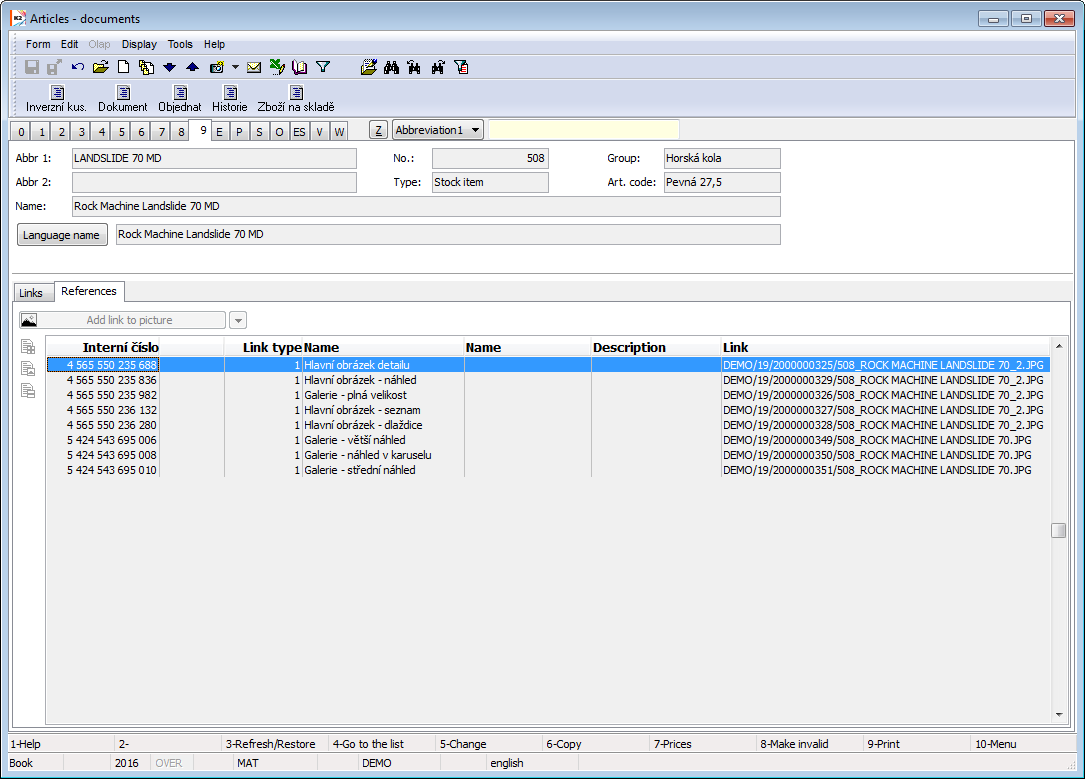
Picture: The Articles book - Attachments - the Links sub-tab
In references, you work with Categories and Types of links.
Overview and settings of Types of links
Type |
Files extensions |
Document |
doc, docx, odt, fodt, rtf, txt, xls, xlsx, ods, fods, csv, sylk, xml, pdf |
Picture |
jpg, jpeg, png, bpm, gif |
Link |
http:, https:, ftp:, sftp: |
Other |
|
Video |
mov, avi, mp4, mpg, mpe, mpeg |
Overview of categories and their default combinations with Types of links
Type |
Category - Abbreviation |
Use for e-shop |
Document |
Documents |
It is displayed on Media tab in the Documents part. |
Picture |
Main picture detail * |
For article detail, banners |
Picture |
Main picture - tile* |
For display in a tiled list of Articles |
Picture |
Main picture - view* |
For basket, history, icons of categories |
Picture |
Main picture - list* |
For display in the line list of Articles |
Picture |
Gallery - view in scroll bar |
To preview the displayed gallery in the scroll bar |
Picture |
Gallery - full size |
Full picture size from gallery |
Picture |
Gallery - medium-size view |
For overview in the gallery |
Picture |
Gallery - larger-size view |
It is not used at this moment. |
Link |
Youtube |
It is displayed on Media tab in Videos and Documents sections. |
Other |
Other |
Not used for e-shop. |
Video |
Videos |
It is displayed on Media tab in Videos section. |
* For the purposes of e-shop, there may be exactly one picture of this category on the Articles or other records tab; Graphically represents the record. |
||
New particular reference can be inserted by the buttons, which are displayed under tab label, by dragging the file to the table or by using Ins key. Then you can set or edit Name and Description of a reference.
Adding new reference by using the button
You can use either the Attach Document button to insert a new link ![]() or New Item (Ins)
or New Item (Ins) ![]() . The Attach Document button allows you to insert a new link from the default combinations of link type and category (see above). The file selection dialog box appears. Depending on the type of link, a filter corresponding to the file extensions of that type is displayed. You can switch the filter off, when you choose All files (*.*) next to the field for a file name. Then you can choose file of random type. By using the Open button, the selected file will be copied on the place, which is set by the Configuration of saving of picture references function, and new record with this reference will be created in the table.
. The Attach Document button allows you to insert a new link from the default combinations of link type and category (see above). The file selection dialog box appears. Depending on the type of link, a filter corresponding to the file extensions of that type is displayed. You can switch the filter off, when you choose All files (*.*) next to the field for a file name. Then you can choose file of random type. By using the Open button, the selected file will be copied on the place, which is set by the Configuration of saving of picture references function, and new record with this reference will be created in the table.
Insert a new link by dragging the file
If you "drag" the file, which is displayed in a folder, into a reference table in the Change mode, an offer of categories according to predefined types will be displayed (e.g. "Document: Documents" will be displayed by dragging .pdf file). By clicking on the required option, a new Link to the selected file will be created. Also in this case, the resource file will be copied onto the place, which is set by the Configure picture link storage function, and a reference is heading here then.
Insert a new link by Ins key
This way is not recommended, because the resource file is not copied - a reference will be created to the path specified by us.
If you press Ins key, the form for adding a new link is displayed. By entering the Type of references, a selection of Categories will be reduced (K2 does not allows us enter other Type of references, than it is set in Category). Then insert the file path.
Note: Standard e-shop or other K2 functionalities usually work with predefined combinations. If we create another combination, or if we do not follow the set combination, it is necessary to verify whether it is actually displayed in the desired way in the e-shop.
"Bulk" insert pictures using the script Add image to item
If you want to create a series of pictures for publication on the web / e-shop, the easiest way is to use a script: for new (template e-shop) New e-shop - Adding pictures to Articles (NewEshop_AddPicture.PAS), for old (responsive e-shop) shop) Eshop - Add pictures to Articles (Eshop_AddPicture.PAS), the use of which is described in detail in the catalogue of scripts.
Adding a Picture to the Article
Script for template e-shop (new version)
Process No.: ESH001 |
Id number of script: FESH023 |
File: NewEshop_AddPicture.pas |
Script Description: The script allows you to import images of articles for a specific item, assign them to the required categories and set the required size. The difference from the older version of the script is that the script does not cut images. Another difference is that the same image is not attached to each article separately, but one attached image is created, which is then attached to the other article. In folder K2 this picture is placed only once with the number of the first article. |
||
Address in the tree: |
||
Script parameters - default value:
AppendToEshop - Attach images to the e-shop, but only as a link. When the parameter is enabled, it is necessary to enter the RID of the E-shop |
ConvertGoodsPictK2 - NO. When the parameter is switched to YES, the required series of images is created from a single (last) image in K2 (stored on the 9th page - Connection with type PICTK2). |
DescrFormatString - Description, formatted text. |
FileMask- File name mask. E.g. [Zkr]_* or [Cis]#* or [Zkr]. [Title] can be used for Categories. The PicturesDirectory must be specified at the same time. |
PictureFile - Path to one image, i.e. the file to be inserted as an image. The parameter is mainly used for automated use, e.g. via RF. |
PicturesDirectory - Image location directory. |
RIDEshop - RID E-shop Number |
TitleFormatString - Name - Formatting Text |
Script for responsive e-shop (older version)
Process No.: ESH001 |
Id number of script: FESH002 |
Soubor:Eshop_AddPicture.pas |
Script Description: The script allows you to import images of articles for a specific item, assign them to the required categories and set the required size. The images are uploaded to the location specified by the K2 function Configure picture link storage. |
||
Address in the tree: |
||
Script parameters - default value:
Eshop_AddPicture.pas - Attach images to the e-shop, but only as a link. When the parameter is enabled, it is necessary to enter the RID of the E-shop |
ConvertGoodsPictK2 - NO. When the parameter is switched to YES, the required series of images is created from a single (last) image in K2 (stored on the 9th page - Connection with type PICTK2). |
DescrFormatString - Description, formatted text. |
FileMask - the text, which must initially contain in square brackets the name of the field that is used to identify the articles, for now it is only the Cis, Zkr, Zkr1, Naz fields for which there are indexes in the articles. It may also contain one character used as a delimiter, it can also contain an * as a substitute character for anything. Examples: [Zkr]_* or [Cis]#* or [Zkr] etc.
The PicturesDirectory must be specified at the same time
|
OnlyAdditionalPictures - NO. An image is created for all link categories. YES - only those categories are created, of which there can be more on the Articles tab. Note: All categories Main Image... can be on the articles only once, all categories Gallery... can be multiple times. |
PictureFile - . The file to be inserted as an image. The parameter is mainly used for automated use, e.g. via RF. |
PicturesDirectory - Image Location Directory |
RIDEshop - RIPEshop |
TitleFormatString - Name - Formatting Text |
Export XML feed for comparator
Process No.: ESH001 |
Id number of script: FESH001 |
File: EshopXmlFeedExport.pas |
Script Description: The script enables to export articles prices for Zbozi.cz, Heureka and Google merchants. The result of the export is three XML files, each of them is created for concrete comparator. The script scans published articles on the e-shop, exports their price and classifies them into the same product category. It is also possible to export article parameter or article availability for both, the main warehouse and the branches warehouses to Heureka.cz server. Elements PRODUCTNAME and PRODUCT exist in the export for Heureka. E-shop name (esName) is added into the PRODUCT element, while Comparator name (esXmlTitle) is added into the PRODUCTNAME if it´s filled. If it is not filled in, it is replaced by the E-shop name. |
||
Address in the tree: |
||
Script parameters - default value:
AllowZeroPrices - No Export articles with zero prices? |
AvailabilityFeedFileName - 'AvailabilityFeed.xml' Output XML file´s name for article availability |
Createlog - after the parameter is switched on, the export settings protocol and the skipped article list is made in users directory during export |
Currency - Currency for price export. If nothing is entered, exported prices are in the currency of the company. |
CustomerID - CustomerID, whose prices are to be exported. It is required to enter this parameter, or parameter PriceGroupID. |
ExportAvailabilityFeed - No Should article availability file be created? |
ExportFileNameGoogle - GoodsFeedGoogle.xml Output XML file´s name for Google Merchant. |
ExportFileNameHeureka - ´GoodsFeedHeureka.xml´ Output XML file´s name for Heureka |
ExportFileNameZbozi - ´GoodsFeedZbozi.xml´ Output XML file´s name for Zbozi.cz |
ExportFolder - Folder, where the file should be exported. |
ExportFolderFTP - It is need to have setted connection to the FTP server for this parameter usage (in Administration and Web and E-shop Settings). Once the connection is setted up and selected, this parameter allows file uploading into the selected directory in FTP. If the folder does not exist, the script will create it by itself. |
ExportFullDescription - Ne Yes - the complete description XML file is exported instead of the short one. |
ExportParametrs - No Yes - the XML file including parameters is exported. |
ExportVatRate - NO Heureka introduced a new element VAT in XML feed https://sluzby.heureka.cz/napoveda/xml-feed/#VAT Mandatory for shops selling articles at different VAT rates in Heureka shopping cart. Necessary for EET (Electronic Sales Record) support in Heureka shopping cart.
Zbozi.cz currently does not have such an element and its validator reports it as an error... |
ImageServerRootUrl - Exported file name. |
IncludeManufacturerInProductName - No Should the brand (manufacturer) be added to the beginning of the product name? |
Language - The language number for export. |
PriceGroupID PriceGroupID whose prices are to be exported. It is required to enter this parameter, or parameter CustomerID. |
ShopRID - ShopRID for article export. |
WeightMode - Export weight for articles; 0 - export off, 1 - net weight, 2 - gross weight |